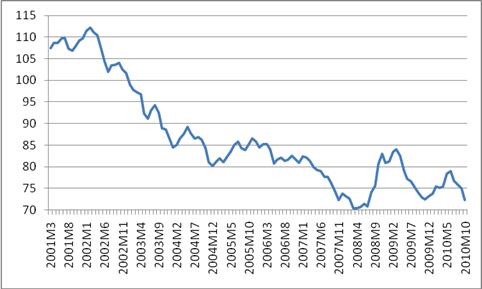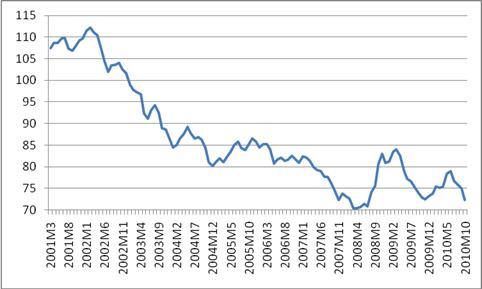Live Big Digest: Managing Political and Economic Risk in Your Portfolio

With the long Thanksgiving weekend nearly upon us, we thought we’d take the liberty of sharing a somewhat longer Live Big Digest devoted to a single topic: how to manage political and macroeconomic risk in your portfolio. We hope you find it interesting.
And here’s wishing you a restful Thanksgiving Day celebration filled with friends, family, and thankful reflections.
The Yeske Buie Team
– Managing Political and Macroeconomic Risk in Your Portfolio
In his latest commentary in the New York Times (There Will Be Blood, https://www.nytimes.com/2010/11/22/opinion/22krugman.html), economist Paul Krugman suggests that “our nation is in much worse shape, much closer to a political breakdown, than most people realize.” Opinions might vary as to how much truth is contained in that statement, but it certainly raises the question of what we can do as savers and investors to protect ourselves from the political and macroeconomic risks that might arise in these wild and contentious times. Here’s our approach:
To begin with, risk means that more things CAN happen than WILL happen, and since the things that can happen are legion, it would be expensive to individually hedge every possible negative contingency. The most efficient way to hedge the greatest number of risks is to diversify along vectors that capture (or encompass) the greatest number of negative scenarios. One way we at Yeske Buie do this is through geographic diversification, since different countries and regions are often subject to different macroeconomic and political conditions. In addition to hedging political and economic risk, we choose to dollar-diversify by selecting only unhedged equity portfolios for our international allocations. Fully half of the equities in any of our portfolios are in non-dollar-denominated assets. It’s worth noting that the non-dollar half of our typical equity allocation got a boost in the past few months, so that even while US markets were doing well, your overseas holdings did even better. If you look at the chart below, you can see the steep drop in the dollar (versus a broad basket of currencies) over the past four months, as well a the secular decline that’s been underway since 2001 (interrupted by an uptick every time the world gets nervous and makes a “flight to quality”). Every time the dollar declines, our foreign equity holdings get a boost, all other things being equal.
Although the geographic and currency vectors are most relevant for mitigating the kinds of political risks that Krugman talks about, the “size” vector is also a significant diversifier, as companies of different sizes and at different stages of development fare differentially at various stages of the business cycle and in the face of different political environments.
A further point worth making is that the risks that can arise as a consequence of fiscal or monetary strategies (and the policy battles that often accompany them) can potentially be very negative for fixed-income investments (“fixed-income” refers to bonds and similar instruments). Since it is our goal to establish a fixed-income allocation that will be a “stable reserve” within the portfolio, we work along three major dimensions to minimize macroeconomic risks. First, we diversify bond holdings globally so that we aren’t subject to a single monetary/fiscal regime. Second, and unlike our approach to equities, we use portfolios that do hedge away the exchange-rate risk, as this can introduce significant volatility to fixed-income portfolios. Finally, mindful of the fact that bonds with longer maturities are more sensitive to rising interest and inflation rates, we choose a mix of portfolios that is significantly skewed toward short and intermediate maturities. Two of the three bond funds that we typically use have average maturities of one year or less, while the third maintains an average maturity well under five years. By contrast, those who stretch for yield now run a significant risk of loss if/when interest rates begin to rise.
On a final note related to government policies, many people have been concerned about the consequences of the US and/or other developed economies finding themselves on a slower growth path. The evidence, however, suggests that markets tend to “price this in” so that slow growth countries, while they may not generate enough jobs to avoid high unemployment and other negative side effects, still produce respectable stock market returns. The table below summarizes the stock market returns produced in countries that experienced slow economic growth over the past 38 years, compared to those countries that experienced rapid growth.
| Developed Markets (1971-2008) |
Avg. Return | Std Deviation | Avg. GDP Gwth |
| High-Growth Countries | 12.90 | 23.07 | 0.92 |
| Low-Growth Countries | 13.52 | 23.04 | -4.02 |
What this shows is that investors around the world are risk-averse and price securities to provide an appropriate risk-adjusted return whatever may be happening in the economy as a whole. We can take this as further evidence that financial markets do a good job of adjusting prices for local conditions in order to ensure investors an appropriate risk-adjusted return.
To summarize: investment risk can arise from many different sources and is best managed when we diversify in ways that mitigate the greatest number of risks at once. Diversifying across geographic, currency, and size dimensions satisfies this multidimensional risk-management goal. It is also important to consider the unique risks associated with fixed-income investments. These are best managed by diversifying globally, hedging against exchange-rate fluctuations, and keeping maturities relatively short.
The risk associated with that third serving of mashed potatoes and gravy, however, is something you’ll have to manage on your own.
Happy Thanksgiving!

